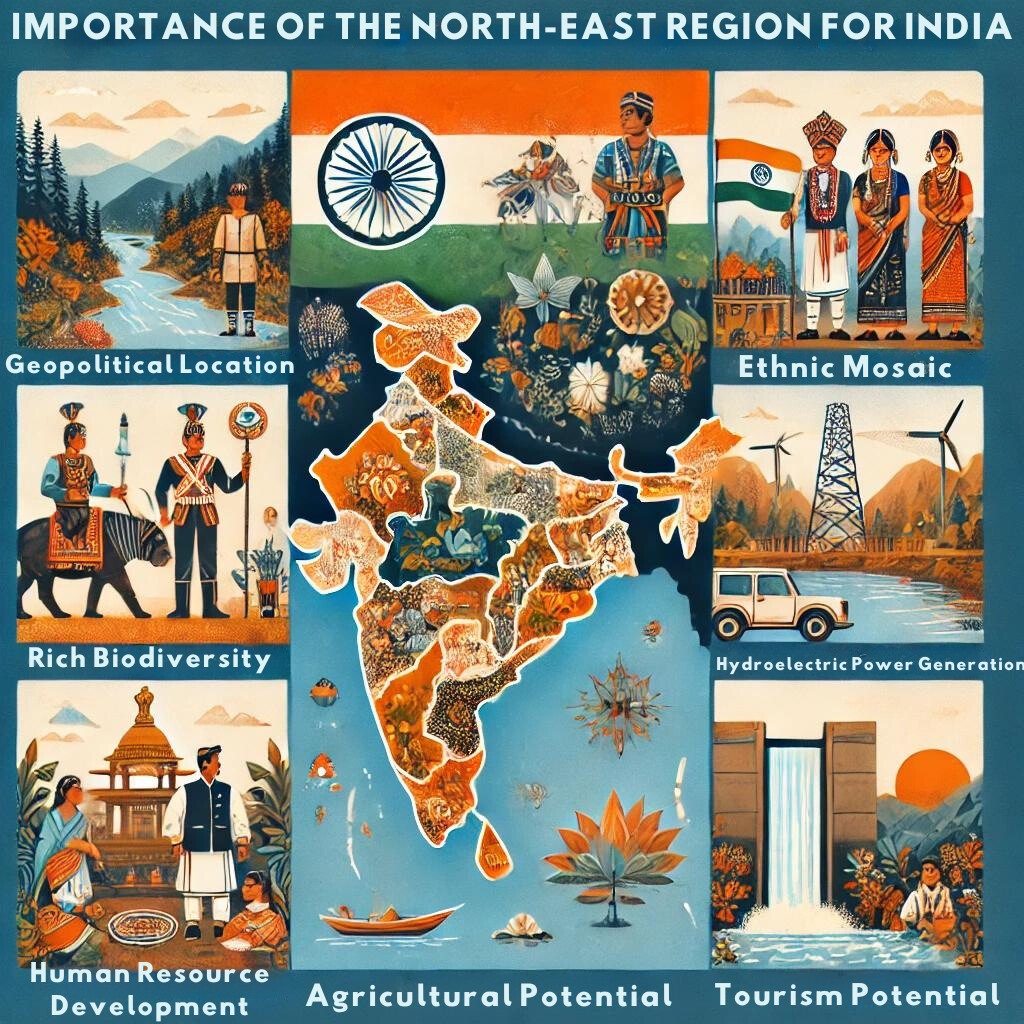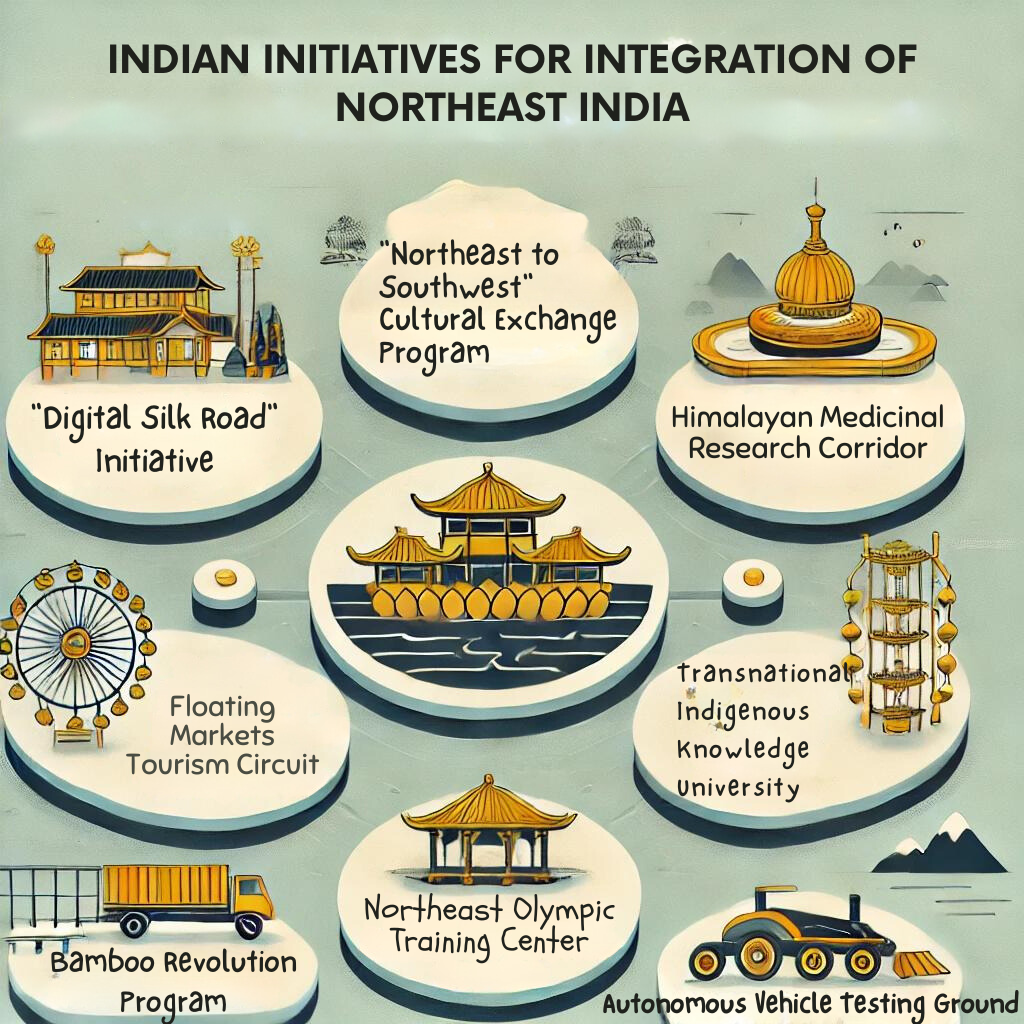India’s Northeast region, nestled in the eastern Himalayas, has stunning landscapes, diverse cultures, and rich tribal heritage. Yet it faces significant challenges in fully integrating its indigenous communities into the mainstream development narrative. Despite its natural resources and vibrant cultural identity, the Northeast struggles with weak infrastructure, limited market access, social inequalities, and recent conflicts like those in Manipur. An example is ginger cultivation in Karbi Anglong, Assam, where a cooperative society aimed to empower indigenous growers but failed due to the weakening of traditional institutions and the dominance of middlemen. This situation underscores the need for India to bridge the gap between the Northeast and the rest of the country, unlocking its potential for cultural richness, economic opportunity, and environmental stewardship.
Origin of the Article
This editorial is based on “Rhetoric of Collective Action in North East India” published in Economics and Political Weekly on June 22, 2024. The article discusses the limited effectiveness of cooperatives in Northeast India, exemplified by GIN-FED relying on traders instead of empowering indigenous growers directly, undermining local community institutions essential for cooperation.
Relevancy for UPSC Students
Understanding the Northeast region is crucial for UPSC aspirants as it is relevant to topics in GS Paper 2 and 3, including infrastructure, growth and development, and government policies. Knowledge of this region can aid in essay writing, current affairs, and preparation for questions related to governance and inclusive growth.

Why in News
The topic is in the news due to the limited effectiveness of cooperatives in Northeast India. The discussion ties into previously asked questions on regional development disparities, cooperative movements, and the Act East policy, underscoring its relevance for comprehensive exam preparation.
Significance of the North-East Region for India
The North-East region holds immense strategic importance for India, serving as a bridge to Southeast Asia. Its unique geographic position, rich biodiversity, and cultural diversity offer significant economic potential. This region is crucial for India’s ‘Act East’ policy, fostering economic and strategic ties with Southeast Asian countries.
Strategic Geopolitical Location
The Northeast’s location is pivotal, acting as an economic corridor to Southeast Asia. Projects like the India-Myanmar-Thailand Trilateral Highway and the Kaladan Multi-Modal Transit Transport Project enhance regional connectivity. These initiatives not only bolster economic ties but also position India as a counterbalance to China’s influence in Southeast Asia.
Rich Biodiversity and Natural Resources
The Northeast is a biodiversity hotspot, home to rare flora and fauna. Its ecosystems range from tropical rainforests to alpine meadows, playing a crucial role in ecological balance. The region’s significant reserves of oil, natural gas, and coal contribute to India’s energy needs, offering both ecological and economic value.
Cultural Diversity and Ethnic Mosaic
The Northeast is a cultural mosaic, with over 220 ethnic groups and numerous dialects. This diversity enriches India’s pluralistic identity and enhances its soft power globally. The region’s unique cultural heritage, including music, dance, and handicrafts, holds immense potential for cultural tourism.
Agricultural and Horticultural Potential
The Northeast’s diverse agro-climatic conditions support a variety of crops. The region is ideal for organic farming, floriculture, and medicinal plant cultivation, aligning with the global demand for organic products. Its agricultural potential is vast, offering significant opportunities for economic growth.
Hydroelectric Power Generation
With abundant water resources and mountainous terrain, the Northeast has immense hydroelectric power potential. An estimated 58,000 MW capacity can contribute significantly to India’s renewable energy goals. Harnessing this potential could meet regional energy needs and support national energy security.
Tourism Potential
The Northeast’s untapped tourism potential is vast, with unique landscapes, wildlife, and cultural heritage. Attractions like Kaziranga National Park and the Living Root Bridges of Meghalaya can draw domestic and international tourists. Promoting tourism can boost local economies and preserve cultural heritage.
Human Resource Development
The Northeast boasts a high literacy rate and a young population, presenting a demographic dividend. Investing in education, skill development, and innovation can harness this potential. The region can become a hub for innovation and entrepreneurship, driving India’s future growth.

Major Challenges Related to India’s Northeast Region
Despite its potential, the Northeast faces significant challenges that hinder its development. Issues range from insurgency and ethnic conflicts to economic and infrastructure deficits, impacting the region’s growth and integration with the rest of India.
Persistent Insurgency and Ethnic Conflicts
Insurgency and ethnic conflicts remain a challenge in the Northeast, with recent violence in Manipur highlighting inter-ethnic tensions. These conflicts threaten security, hinder development, and deter foreign investment, creating a cycle of underdevelopment and unrest.
Agricultural Challenges
Agriculture in the Northeast faces hurdles like limited success in organic farming and the dominance of middlemen. Cooperatives like the Ginger Growers Cooperative Federation struggle to compete, leaving farmers reliant on exploitative traders, which undermines their economic potential.
China’s Growing Influence and Border Disputes
China’s claims over Arunachal Pradesh and border infrastructure development pose security challenges. Clashes in regions like Tawang and Doklam underscore tensions. China’s economic influence in Myanmar further complicates India’s strategic interests in the Northeast.
Climate Change and Environmental Degradation
The Northeast is highly vulnerable to climate change, experiencing erratic rainfall, flooding, and landslides. Events like the 2022 Assam floods exemplify these impacts, threatening livelihoods and exacerbating environmental degradation.
Infrastructure Deficit and Connectivity Issues
Infrastructure deficits and connectivity issues persist in the Northeast, despite efforts like the Act East Policy. Slow progress of key projects and poor last-mile connectivity impact healthcare, education, and economic opportunities, particularly in remote areas.
Economic Underdevelopment and Unemployment
The Northeast’s economy remains largely agrarian with limited industrialization. High youth unemployment fuels social unrest and out-migration, leading to a brain drain. Initiatives like the North East Industrial Development Scheme have had limited success in attracting investments.
Drug Trafficking and Cross-border Crime
Proximity to the Golden Triangle makes the Northeast vulnerable to drug trafficking. Increased drug seizures and rising addiction rates pose law enforcement challenges and strain the region’s healthcare and social fabric.
Political Instability and Governance Issues
Frequent government changes and ethnic politics hinder policy continuity in the Northeast. National political dynamics and controversies, like those over the Citizenship Amendment Act, exacerbate political instability, complicating governance and development efforts.
PESTEL Analysis
| Political: The Northeast faces political instability and complex ethnic politics, leading to unstable coalitions and policy discontinuity. The impact of insurgencies and ethnic conflicts further complicates governance, hindering development initiatives and fostering a cycle of underdevelopment. Economic: Economic underdevelopment and unemployment are prevalent, with limited industrialization driving social unrest and outmigration. However, the region holds potential through its natural resources, hydroelectric power capabilities, and agricultural prospects. Strategic investments in these areas could stimulate economic growth. Social: The Northeast is home to over 220 ethnic groups, offering immense cultural richness yet facing challenges like drug trafficking and social unrest due to unemployment. Initiatives like cultural exchange programs and enhanced education systems could leverage this diversity for broader social integration and development. Technological: There is a significant opportunity to advance technological infrastructure in the region. Proposals such as developing digital networks and establishing it as a hub for digital innovation could integrate the Northeast into India’s broader digital economy and spur local innovation. Environmental: Environmental challenges include vulnerability to climate change impacts like erratic rainfall and flooding. The region’s rich biodiversity necessitates sustainable management to preserve its ecological balance while supporting economic activities like tourism and agriculture. Legal: Legal issues arise from border disputes with China and internal security concerns. Enhanced legal frameworks and cooperation with central authorities are needed to stabilize the region and promote development. |
How can India Strengthen the Integration of Northeast India?
Strategic initiatives are needed to enhance the socio-economic development and connectivity of the Northeast. These initiatives aim to integrate the region more comprehensively with the rest of India, leveraging its unique potential for national growth.
“Northeast to Southwest” Cultural Exchange Program
A cultural exchange program between the Northeast and southwestern states can foster understanding and integration. Year-long student exchanges, artist residencies, and business incubation programs can create deep, personal connections, promoting grassroots integration.
“Digital Silk Road” Initiative
Developing a digital infrastructure network can position the Northeast as a hub for digital innovation. Establishing a “Silicon Valley of the East” with tax incentives and digital skills training can integrate the region into India’s digital economy and potentially make it a leader in the field.
Transnational Indigenous Knowledge University
A university focused on indigenous knowledge systems can make the Northeast a cultural and intellectual bridge between South and Southeast Asia. This institution can become a global center for studying and preserving indigenous cultures, traditional medicine, and sustainable agriculture.
Northeast Olympic Training Center
Creating an Olympic training center in the Northeast can leverage the region’s sports enthusiasm. This facility can train athletes in various Olympic sports, bringing national and international attention to the region and fostering pride and integration through sports.
Floating Markets Tourism Circuit
Developing floating markets inspired by Southeast Asian models can boost local economies and tourism. These markets can showcase the region’s diversity, creating a distinctive Northeast brand within India’s tourism landscape and attracting tourists.
Bamboo Revolution Program
A national program centered on bamboo cultivation and product development can drive economic integration. The Northeast can become the epicenter of a sustainable “bamboo economy,” positioning it as a leader in eco-friendly innovation and boosting local industries.
Himalayan Medicinal Research Corridor
A research corridor focusing on traditional Himalayan medicine can integrate the Northeast’s knowledge with Ayurveda and modern biotechnology. This initiative can position the region as a global leader in alternative medicine research and production, driving economic growth.
Autonomous Vehicle Testing Ground
Designating parts of the Northeast as testing zones for autonomous vehicles can attract global auto and tech companies. The region’s unique landscape offers challenging terrains for testing, integrating the Northeast into the future of transportation technology.

Conclusion
In conclusion, the Northeast region of India stands as a testament to the country’s rich diversity and untapped potential. Addressing its unique challenges through targeted initiatives can unlock unprecedented growth and integration. For UPSC aspirants, understanding the intricate dynamics of the Northeast is crucial, as it holds significant implications for India’s socio-economic and geopolitical landscape.
| UPSC Civil Services Examination, Previous Year Questions (PYQs) Mains Q. Discuss the impact of the India-Myanmar-Thailand Trilateral Highway and the Kaladan Multi-Modal Transit Transport Project on India’s ‘Act East’ policy. (GS-II, 2022) Q. Analyze the challenges faced by the North East Industrial Development Scheme in promoting industrial growth in India’s northeastern region. Suggest measures to overcome these challenges. |


